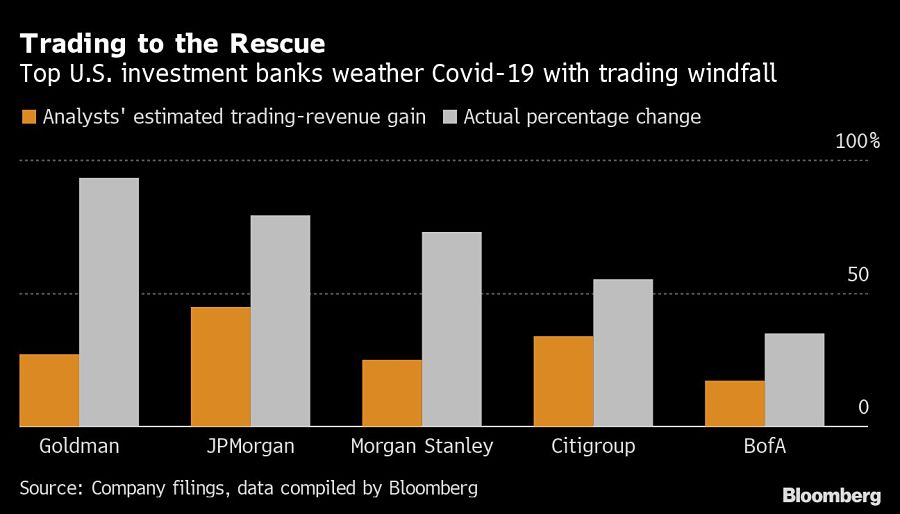

Morgan Stanley wrapped up a week of wins for Wall Street trading desks, capitalizing on the Federal Reserve’s extraordinary rescue measures with record profit.
Fixed-income trading revenue almost tripled, driving a 73% jump in total trading that surged past expectations, according to a statement Thursday. That spurred firmwide revenue and earnings to all-time highs amid wild market swings caused by the coronavirus pandemic.
“It’s clear that a lot of people did well in light of client activity,” CFO Jonathan Pruzan said in an interview. While much of that has continued in the first few weeks of the third quarter, “we would expect a reversion to a more normalized level,” he said.
The gains brought the overall trading haul total for the five biggest U.S. investment banks to $33 billion, a windfall that helped all of them survive the brunt of the coronavirus pandemic with profits intact.

As the Covid-19 outbreak intensified earlier this year, the Fed cleared the way for companies to access desperately needed cash with programs that effectively served as credit backstops, allowing markets to thaw. That, in turn, spurred demand for Wall Street’s trading and underwriting services.
“Our decade long business transformation was intended to provide stability during times of serious stress,” Chief Executive James Gorman said in the statement. “The second quarter tested the model and we performed exceedingly well, delivering record results.”
Morgan Stanley’s trading gains come at a critical juncture for the bank, which is leaning on the business to shore up earnings as it makes a bigger pivot toward managing money for others. The bank’s pact to purchase ETrade Financial Corp. in February is set to be the biggest acquisition by a top U.S. bank since the financial crisis, and a sign of Gorman doubling down on the success of his firm’s Smith Barney purchase a decade ago.
Fixed-income trading revenue at Morgan Stanley came in at $3.03 billion, compared with the $1.81 billion analysts were predicting, based on estimates compiled by Bloomberg. Equities trading revenue rose to $2.62 billion, higher than the $2.27 billion average estimate.
Morgan Stanley’s stock is little changed since the start of the year, the best performance among the top five banks and a show of resilience that kept the firm’s market capitalization above that of Goldman Sachs Group Inc. -- a perennial rival -- for much of the year. Shares of the company, which had gained 8.1% since July 9, were little changed at 8:12 a.m. in early New York trading.
Investment bankers at the firm posted revenue of $2.05 billion on the strength of a 64% jump in underwriting revenue, as the firm took its share of the surge in new stock and debt issuance by corporate America.
Wealth management revenue, which typically accounts for about half of Morgan Stanley’s total, rose 6% to $4.68 billion.

Looking to refine your strategy for investing in stocks in the US market? Discover expert insights, key trends, and risk management techniques to maximize your returns

The RIA led by Merrill Lynch veteran John Thiel is helping its advisors take part in the growing trend toward fee-based annuities.

Driven by robust transaction activity amid market turbulence and increased focus on billion-dollar plus targets, Echelon Partners expects another all-time high in 2025.

The looming threat of federal funding cuts to state and local governments has lawmakers weighing a levy that was phased out in 1981.

The fintech firms' new tools and integrations address pain points in overseeing investment lineups, account monitoring, and more.
RIAs face rising regulatory pressure in 2025. Forward-looking firms are responding with embedded technology, not more paperwork.
As inheritances are set to reshape client portfolios and next-gen heirs demand digital-first experiences, firms are retooling their wealth tech stacks and succession models in real time.
